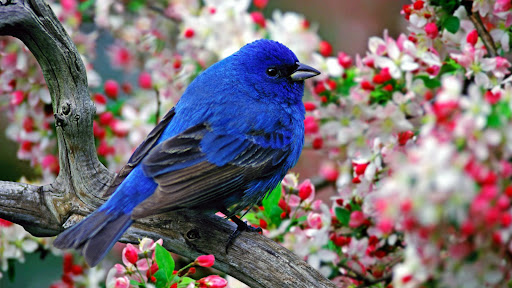
Early in April there is a colorful visitor that comes to our area. He is one of our first returnees from the tropics for the summer.
Indigo buntings appear in the Central Savannah River Area about the time lawns, roadsides and meadows are filled with dandelion seed puffs and when crabgrass, sock and other weeds spring up.
When we first moved to our present location, indigos visited us every spring. We had a little pool situated under small pines in the backyard. Looking back, I see where our backyard was probably a cotton patch at one time. Through the years it was abandoned as a field and now was being taken over by mostly pines, thick vines, shrubbery and residences.
Indigos had probably used this space for nesting, rearing young and singing from high perches from time immemorial. Birds are known (by banding) to return to the former year's nesting sites with regularity. Now we have taken their home site for our own, for we don't see them around the yard anymore.
Indigos are small birds measuring only 5 1/2 inches from bill tip to tail tip. The adult male indigo is our only small, all blue North American finch. In the fall, the male molts into plumage much like the female but there is always enough blue in the wings and tail to identify him. During the fall molt he could be confused with the blue grosbeak but for his smaller size.
Adult females are warm yellowish-brown above pale buff below. She has no discernible streaks or wing bars as other little brown female birds do. Though the young look similar to the female, prominent streaks on the breast tell you who they are.
Indigos seek out brushy cover close to the ground for nesting. But it must be near high perches for the elegant male to sit all day and pour out his exuberant and ceaseless song. A song expert says this about the indigo's song: "One remarkable song that can give an idea of the rhythm was zay-zay zreet zay zay zeah zay-zay- seeteeteet zit-zit zeah." The remarkable thing about this is that the rhythm is exactly like that of a well known human jingle. "Bean porridge hot, bean porridge cold. Bean porridge in the pot, nine days old."
It has been determined that different individuals have songs of many patterns. If you hear a bird singing but are not sure it is an indigo, search it out for certain identification.
Male indigos sing all day throughout the hot days of summer. The hotter the days, the more intense their singing.
Bark strips, weed stems, broad grass blades and skeletonized leaves make up the thick walled nest. It is lined with fine grasses or hair and is usually placed low in the shrubs or branches of prickly vines or bushes. Three to four white eggs with a bluish or greenish tinge are laid. Incubation is 12 days, with nestling fledging in about the same number of days.
Fall migration begins late in August or early September for these brilliant birds and may continue through early November. Some indigos winter in Florida but the preponderance of the massive flocks move on to Cuba, Mexico and Central America.
You will know another season has rolled around when you no longer hear the incessant singing of the indigo.
